Numerical Analysis of Air Quality Improvement and Thermal Comfort in a Classroom Using Organic Air Cleaners
Abstract
1. Introduction
2. Materials and Methods
2.1. Case Studies
2.2. Governing Equations
2.3. Discretization
2.4. Convergence
2.5. Validation
3. Results
3.1. Airflow Behavior
3.2. Temperature Behavior
3.3. Behavior of CO2 Levels
3.4. Reduction of Carbon Dioxide Levels by Implementing OACs in the Classroom
3.5. Hybrid Proposal for CO2 Concentration Reduction
3.6. CO2 Removal Effectiveness
4. Discussion
5. Conclusions
- Implementing extractors in the classroom increases the primary streams that promote the displacement of contaminated air, reducing average CO2 concentrations and improving indoor air quality.
- With one and two extractors, the average temperatures achieved fall within the thermal comfort values, ranging between 23 °C and 26 °C.
- The hybrid ventilation strategy, which uses one extractor with a flow of 23.20 m3/min and two OACs, reduces contaminant levels to 613 ppm and keeps them within permissible levels.
Author Contributions
Funding
Institutional Review Board Statement
Informed Consent Statement
Data Availability Statement
Acknowledgments
Conflicts of Interest
References
- Ge, Z.; Xu, G.; Poh, H.J.; Ooi, C.C.; Xing, X. CFD Simulations of thermal comfort for naturally ventilated school buildings. IOP Conf. Ser. Earth Environ. Sci. 2019, 238, 012073. [Google Scholar] [CrossRef]
- Ang, A.S.T.; Sia, C.C.V.; Yeu, Y.L.; Chong, K.H.; Chia, C.S.; Joseph, A. Natural ventilation and indoor air quality in domestic school building: CFD simulation and improvement strategies. CFD Lett. 2023, 16, 1–14. [Google Scholar] [CrossRef]
- Buratti, C.; Palladino, D.; Moretti, E. Prediction of indoor conditions and thermal comfort using CFD simulations: A case study based on experimental data. Energy Procedia 2017, 126, 115–122. [Google Scholar] [CrossRef]
- Kwong, Q.J.; Yang, J.Y.; Ling, O.H.L.; Edwards, R.; Abdullah, J. Thermal comfort prediction of air-conditioned and passively cooled engineering testing centres in a higher educational institution using CFD. Smart Sustain. Built Environ. 2020, 10, 18–36. [Google Scholar] [CrossRef]
- Husain, H.; Mohd Samidi, M.Z.; Meon, M.S. CFD analysis of thermal comfort in hospital operation room with different air distribution design and operative temperature. J. Appl. Eng. Des. Simul. 2021, 1, 59–73. [Google Scholar] [CrossRef]
- Alkhalaf, M.; Ilinca, A.; Hayyani, M.Y.; Martini, F. Impact of diffuser location on thermal comfort inside a hospital isolation room. Designs 2024, 8, 19. [Google Scholar] [CrossRef]
- Sobhi, M.; Khalil, E.E. CFD investigation of air flow patterns and thermal comfort in a room with diverse heating systems. Curr. Environ. Eng. 2019, 6, 150–158. [Google Scholar] [CrossRef]
- Noman, F.G.; Kamsah, N.; Mohamed Kamar, H. Improvement of thermal comfort inside a mosque building. J. Teknol. 2016, 78, 9–18. [Google Scholar] [CrossRef][Green Version]
- Muhieldeen, M.W.; Kuang, Y.C. Saving energy costs by combining air-conditioning and aircirculation using CFD to achieve thermal comfort in the building. J. Adv. Res. Fluid Mech. Therm. Sci. 2019, 58, 84–99. [Google Scholar]
- Losi, G.; Bonzanini, A.; Aquino, A.; Poesio, P. Analysis of thermal comfort in a football stadium designed for hot and humid climates by CFD. J. Build. Eng. 2021, 33, 101599. [Google Scholar] [CrossRef]
- Essah, E.A.; Yao, R.; Short, A. Assessing stack ventilation strategies in the continental climate of Beijing using CFD simulations. Int. J. Vent. 2016, 16, 61–80. [Google Scholar] [CrossRef]
- Lim, T.; Kim, D.D. Thermal comfort assessment of the perimeter zones by using CFD simulation. Sustainability 2022, 14, 15647. [Google Scholar] [CrossRef]
- Palka Bayard de Volo, E.; Pulvirenti, B.; Jahanbin, A.; Guidorzi, P.; Semprini, G. Numerical analysis on the optimisation of thermal comfort levels in an office located inside a historical building. Appl. Sci. 2023, 13, 2954. [Google Scholar] [CrossRef]
- Daithankar, N.; Udawant, K.D.; Karanth, N.V. Prediction of thermal comfort inside a midibus passenger cabin using CFD and its experimental validation. SAE Tech. Pap. 2015, 26, 1–13. [Google Scholar] [CrossRef]
- Zhai, Z.J.; Xue, Y.; Chen, Q. Inverse design methods for indoor ventilation systems using CFD-based multi-objective genetic algorithm. Build. Simul. 2014, 7, 661–669. [Google Scholar] [CrossRef]
- Back, Y.; Kumar, P.; Bach, P.M.; Rauch, W.; Kleidorfer, M. Integrating CFD-GIS modelling to refine urban heat and thermal comfort assessment. Sci. Total Environ. 2023, 858, 159729. [Google Scholar] [CrossRef]
- Izadyar, N.; Miller, W.; Rismanchi, B.; Garcia-Hansen, V.; Matour, S. Balcony design and surrounding constructions effects on natural ventilation performance and thermal comfort using CFD simulation: A case study. J. Build. Perform. Simul. 2023, 16, 537–556. [Google Scholar] [CrossRef]
- Semprini, G.; Jahanbin, A.; Pulvirenti, B.; Guidorzi, P. Evaluation of thermal comfort inside an office equipped with a fan coil HVAC system: A CFD approach. Future Cities Environ. 2019, 5, 1–10. [Google Scholar] [CrossRef]
- Yau, Y.H.; Rajput, U.A. Thermal comfort assessment and design guidelines of a VRF-integrated stratum ventilation system for a large tropical building. Arab. J. Sci. Eng. 2022, 47, 16149–16170. [Google Scholar] [CrossRef]
- Zhang, L.; Mao, Y.; Tu, Q.; Wu, X.; Tan, L. Effects of supply parameters of stratum ventilation on energy utilization efficiency and indoor thermal comfort: A computational approach. Math. Probl. Eng. 2021, 2021, 6615148. [Google Scholar] [CrossRef]
- Yau, Y.H.; Chuah, K.H.; Siew, M.T. The study on thermal environment and airflow pattern in an UFAD system under a cooling mode. Arab. J. Sci. Eng. 2019, 45, 891–908. [Google Scholar] [CrossRef]
- Heidarinejad, G.; Shokrollahi, S.; Pasdarshahri, H. An investigation of thermal comfort, IAQ, and energy saving in UFAD systems using a combination of Taguchi optimization algorithm and CFD. Adv. Build. Energy Res. 2020, 15, 799–817. [Google Scholar] [CrossRef]
- Putra, J.C.P. A study of thermal comfort and occupant satisfaction in office room. Procedia Eng. 2017, 170, 240–247. [Google Scholar] [CrossRef]
- Yang, L.; Ye, M.; He, B.-J. CFD simulation research on residential indoor air quality. Sci. Total Environ. 2014, 472, 1137–1144. [Google Scholar] [CrossRef]
- Stevanovic, Z.; Ilic, G.; Vukic, M.; Zivkovic, P.; Blagojevic, B.; Banjac, M. CFD simulations of thermal comfort in naturally ventilated primary school classrooms. Therm. Sci. 2016, 20, 287–296. [Google Scholar] [CrossRef]
- Angeles-Rodríguez, L.; Celis, C. Numerical study and optimization of air-conditioning systems grilles used in indoor environments. Int. J. Energy Environ. Eng. 2021, 12, 787–804. [Google Scholar] [CrossRef]
- Istiadji, A.D.; Satwiko, P.; Suhodo, Y.P.; Sekarlangit, N.; Prasetya, A.; Silvia, I. The development of an organic air cleaner (OAC) to reduce CO2 level of air-conditioned rooms without fresh air supply. Int. J. Vent. 2020, 21, 195–212. [Google Scholar] [CrossRef]
- Jahanbin, A.; Semprini, G. Numerical study on indoor environmental quality in a room equipped with a combined HRV and radiator system. Sustainability 2020, 12, 10576. [Google Scholar] [CrossRef]
- Jahanbin, A. Efficacy of coupling heat recovery ventilation and fan coil systems in improving the indoor air quality and thermal comfort condition. Energy Built Environ. 2022, 3, 478–495. [Google Scholar] [CrossRef]
- Chen, Z.; Xin, J.; Liu, P. Air quality and thermal comfort analysis of kitchen environment with CFD simulation and experimental calibration. Build. Environ. 2020, 172, 106691. [Google Scholar] [CrossRef]
- Liu, S.; Cao, Q.; Zhao, X.; Lu, Z.; Deng, Z.; Dong, J.; Lin, X.; Qing, K.; Zhang, W.; Chen, Q. Improving indoor air quality and thermal comfort in residential kitchens with a new ventilation system. Build. Environ. 2020, 180, 107016. [Google Scholar] [CrossRef]
- Conceição, E.; Santiago, C.; Lúcio, M.; Awbi, H. Predicting the air quality, thermal comfort and draught risk for a virtual classroom with desk-type personalized ventilation systems. Buildings 2018, 8, 35. [Google Scholar] [CrossRef]
- Zhao, W.; Mustakallio, P.; Lestinen, S.; Kilpeläinen, S.; Jokisalo, J.; Kosonen, R. Numerical and experimental study on the indoor climate in a classroom with mixing and displacement air distribution methods. Buildings 2022, 12, 1314. [Google Scholar] [CrossRef]
- Al-Rawi, M.; Lazonby, A.; Wai, A.A. Assessing indoor environmental quality in a crowded low-quality built environment: A case study. Atmosphere 2022, 13, 1703. [Google Scholar] [CrossRef]
- Duan, Z.; Sun, Y.; Wang, M.; Hu, R.; Dong, X. Evaluation of mixed-mode ventilation thermal performance and energy saving potential from retrofitting a Beijing office building. Buildings 2022, 12, 793. [Google Scholar] [CrossRef]
- Staveckis, A.; Borodinecs, A. Impact of impinging jet ventilation on thermal comfort and indoor air quality in office buildings. Energy Build. 2021, 235, 110738. [Google Scholar] [CrossRef]
- Aryal, P.; Leephakpreeda, T. Effects of partition on thermal comfort, indoor air quality, energy consumption, and perception in air-conditioned buildings. J. Sol. Energy Eng. 2016, 138, 051005. [Google Scholar] [CrossRef]
- Aryal, P.; Leephakpreeda, T. CFD analysis on thermal comfort and indoor air quality affected by partitions in air-conditioned building. Appl. Mech. Mater. 2016, 836, 121–126. [Google Scholar] [CrossRef]
- Amini, R.; Ghaffarianhoseini, A.; Ghaffarianhoseini, A.; Berardi, U. Numerical investigation of indoor thermal comfort and air quality for a multi-purpose hall with various shading and glazing ratios. Therm. Sci. Eng. Prog. 2021, 22, 100812. [Google Scholar] [CrossRef]
- Pamonpol, K.; Areerob, T.; Prueksakorn, K. Indoor air quality improvement by simple ventilated practice and Sansevieria trifasciata. Atmosphere 2020, 11, 271. [Google Scholar] [CrossRef]
- Cao, S.-J.; Deng, H.-Y. Investigation of temperature regulation effects on indoor thermal comfort, air quality, and energy savings toward green residential buildings. Sci. Technol. Built Environ. 2019, 25, 309–321. [Google Scholar] [CrossRef]
- Li, K.; Xue, W.; Liu, G. Exploring the environment/energy Pareto optimal front of an office room using computational fluid dynamics-based interactive optimization method. Energies 2017, 10, 231. [Google Scholar] [CrossRef]
- El-Fil, B.; Ghaddar, N.; Ghali, K. Optimizing performance of ceiling-mounted personalized ventilation system assisted by chair fans: Assessment of thermal comfort and indoor air quality. Sci. Technol. Built Environ. 2016, 22, 412–430. [Google Scholar] [CrossRef]
- Mahdi, A.A.; Abbas, S. Investigating indoor air quality and thermal comfort using different ventilation systems under Iraqi climate. Iraqi J. Mech. Mater. Eng. 2018, 18, 422–435. [Google Scholar] [CrossRef]
- Ye, Y.; Aizezi, N.; Feng, J.; Han, B.; Li, X.; Su, Z.; Li, L.; Liu, Y. Advanced characterization of industrial smoke: Particle composition and size analysis with single particle aerosol mass spectrometry and optimized machine learning. Anal. Chem. 2025, 97, 5554–5562. [Google Scholar] [CrossRef] [PubMed]
- Alkhalaf, M.; Ilinca, A.; Hayyani, M.Y. CFD investigation of ventilation strategies to remove contaminants from a hospital room. Designs 2023, 7, 5. [Google Scholar] [CrossRef]
- Zhao, W.; Ejaz, M.F.; Kilpeläinen, S.; Jokisalo, J.; Kosonen, R. The potential of local exhaust combined with mixing and displacement ventilation systems to mitigate COVID-19 transmission risks. Build. Environ. 2024, 266, 112076. [Google Scholar] [CrossRef]
- Cui, D.; Liang, S.; Wang, D. Observed and projected changes in global climate zones based on Köppen climate classification. WIREs Clim. Change 2021, 12, e701. [Google Scholar] [CrossRef]
- ANSI/ASHRAE Standard 62.1-2019 ed.; ASHRAE, Ventilation for Acceptable Indoor Air Quality. ASHRAE: Atlanta, GA, USA, 2019.
- Glowinski, R. Numerical Methods for Fluids. Handbook of Numerical Analysis; Part, 3; Garlet, P.G., Lions, J.L., Eds.; Elsevier: Amsterdam, The Netherlands, 2003. [Google Scholar]
- Brenner, S.C.; Scott, L.R. The Mathematical Theory of Finite Element Methods, 3rd ed.; Springer: New York, NY, USA, 2008. [Google Scholar]
- Saury, D.; Rouger, N.; Djanna, F.; Penot, F. Natural convection in an air-filled cavity: Experimental results at large Rayleigh numbers. Int. Commun. Heat Mass Transf. 2011, 38, 679–687. [Google Scholar] [CrossRef]
- Ampofo, F.; Karayiannis, T.G. Experimental benchmark data for turbulent natural convection in an air-filled square cavity. Int. J. Heat Mass Transf. 2003, 46, 3551–3572. [Google Scholar] [CrossRef]
- ISO 7730; Ergonomics of the Thermal Environment—Analytical Determination and Interpretation of Thermal Comfort Using Calculation of the PMV and PPD Indices and Local Thermal Comfort Criteria. International Standardization Organization: Geneva, Switzerland, 2005.
- Hesaraki, A.; Myhren, J.A.; Holmberg, S. Influence of different ventilation levels on indoor air quality and energy savings: A case study of a single-family house. Sustain. Cities Soc. 2015, 19, 165–172. [Google Scholar] [CrossRef]
- Wani, M.; Swain, A.; Ukil, A.; Ploder, M.; Koole, R. Optimizing the overall performance of forced extraction systems: A multi-objective framework. Build. Environ. 2022, 221, 109214. [Google Scholar] [CrossRef]
- Sanchez, M.; Toutant, A.; Bataille, F. Numerical simulations and analysis of a low consumption hybrid air extractor. J. Fluids Eng. 2017, 139, 121103. [Google Scholar] [CrossRef]


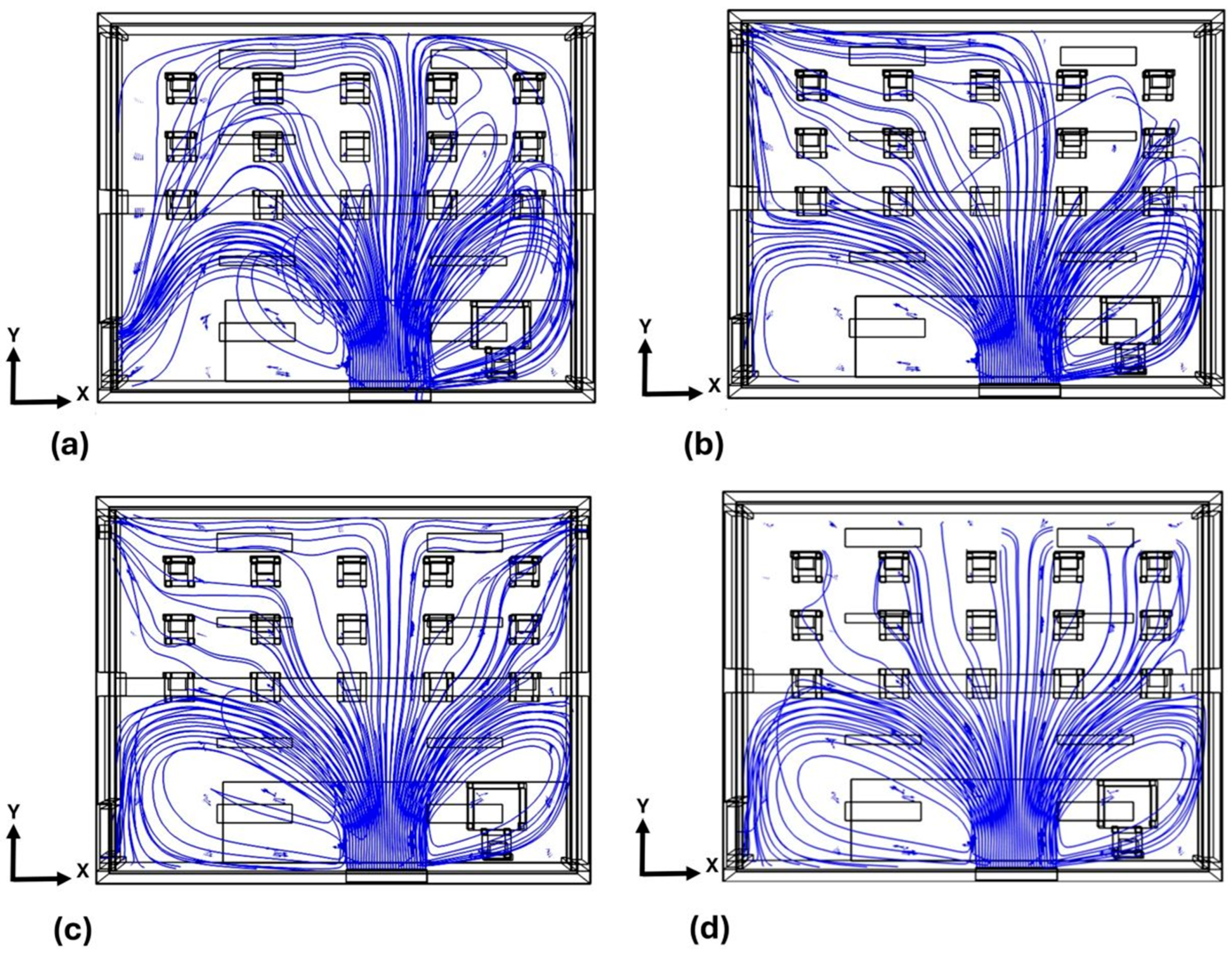
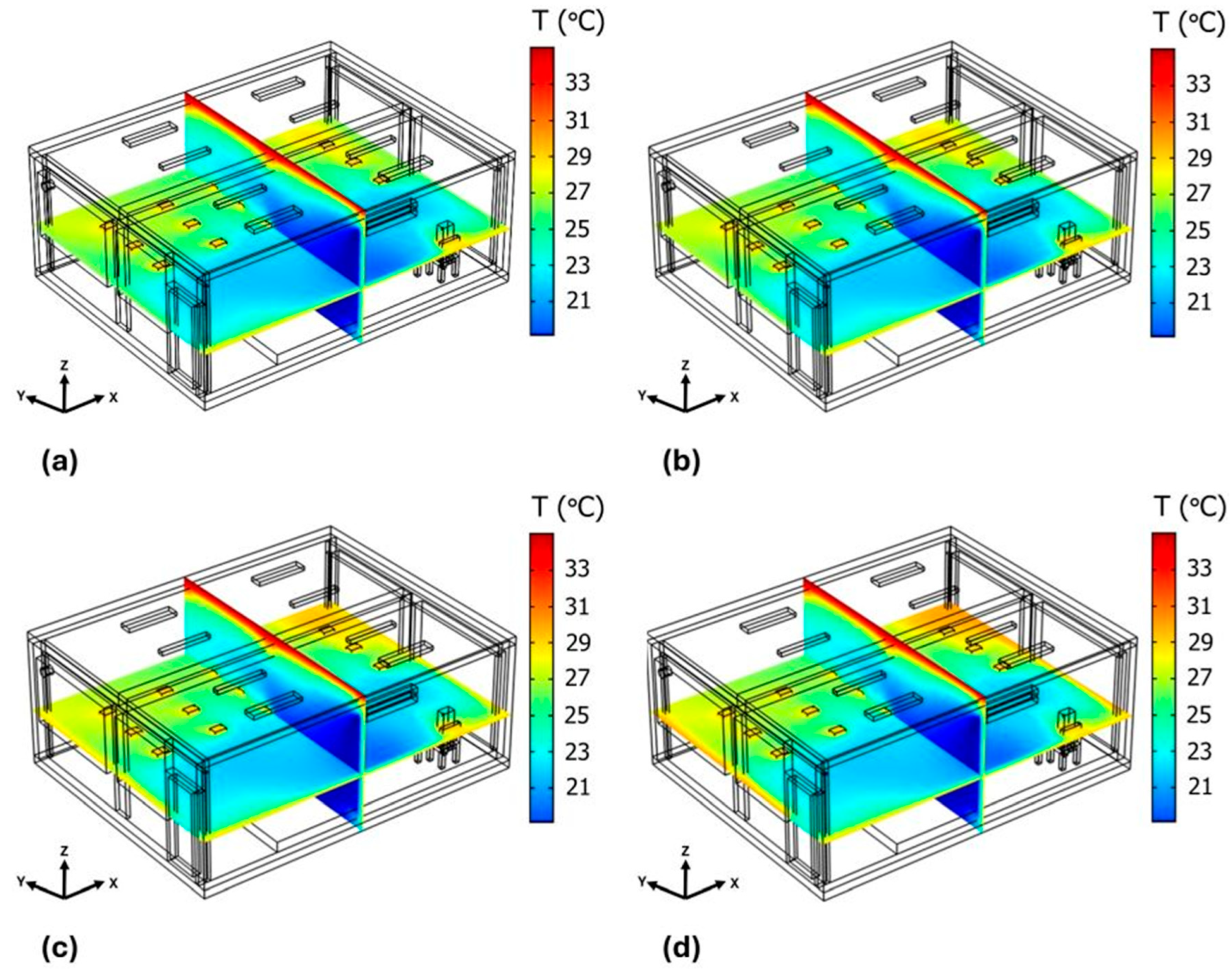
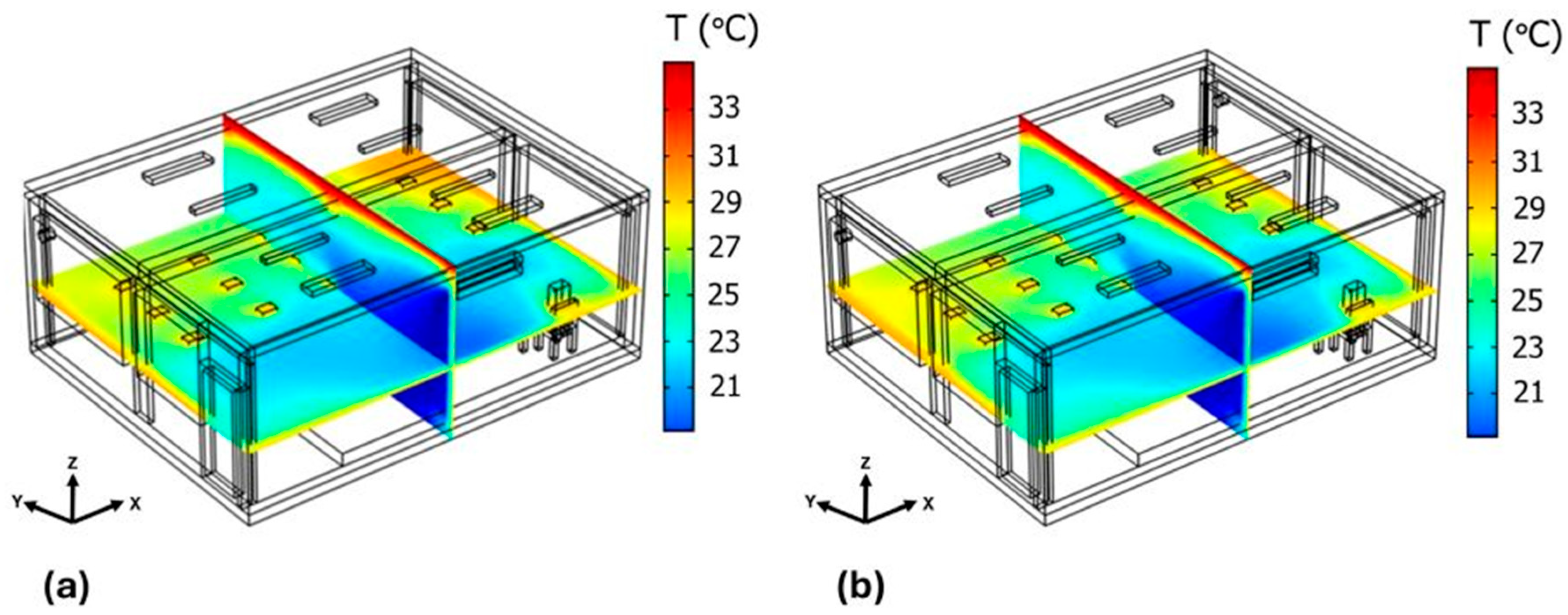


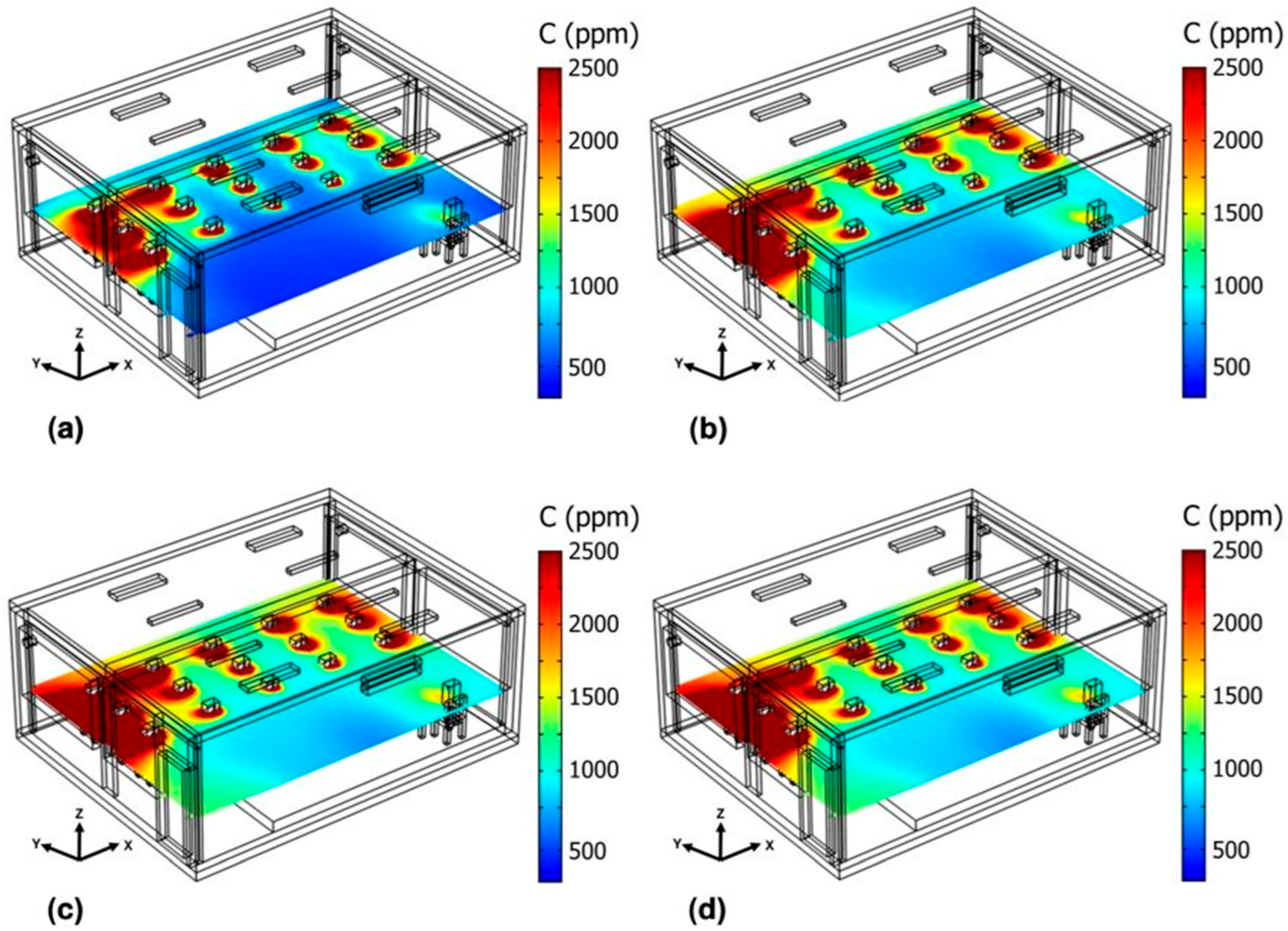

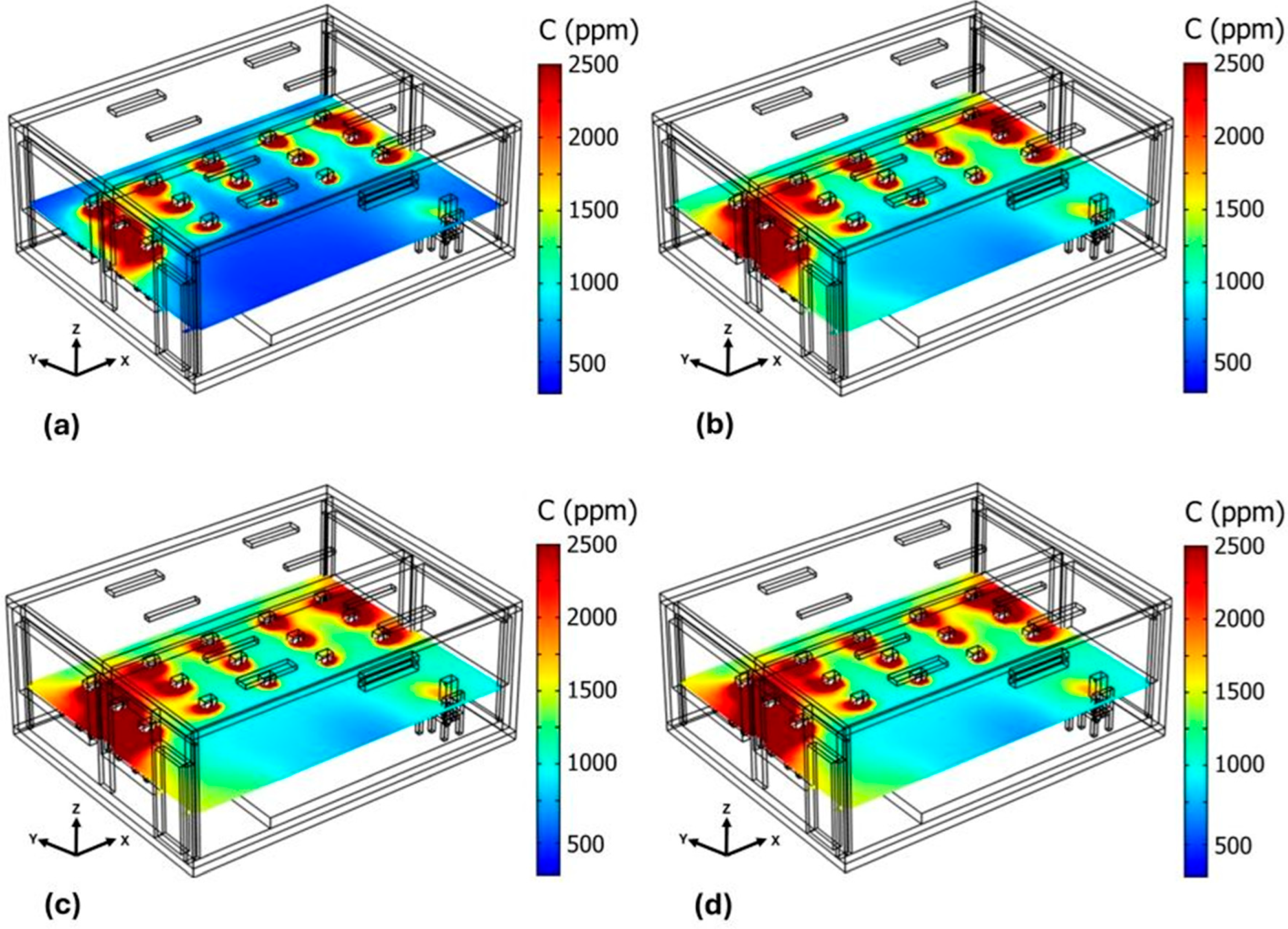
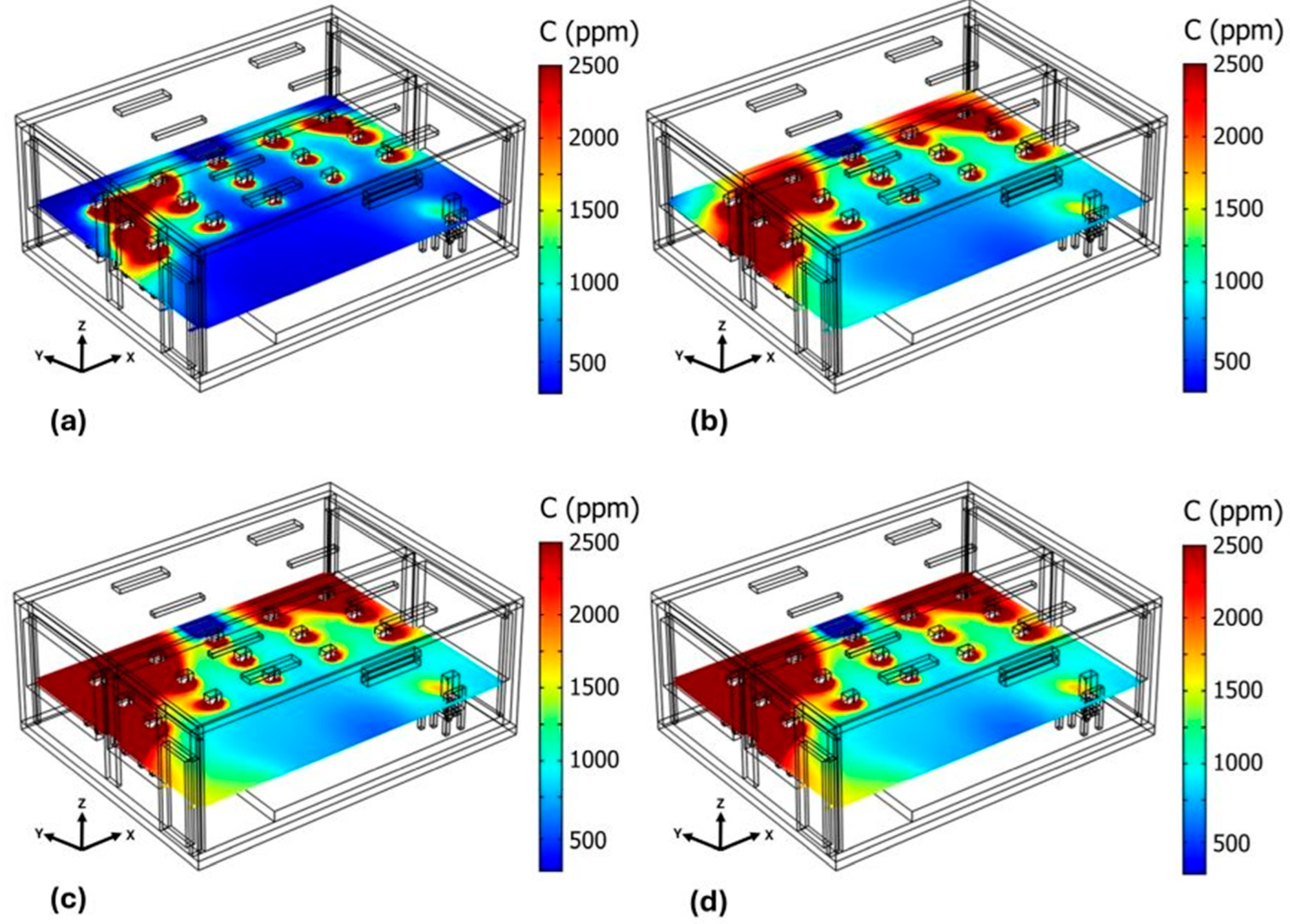
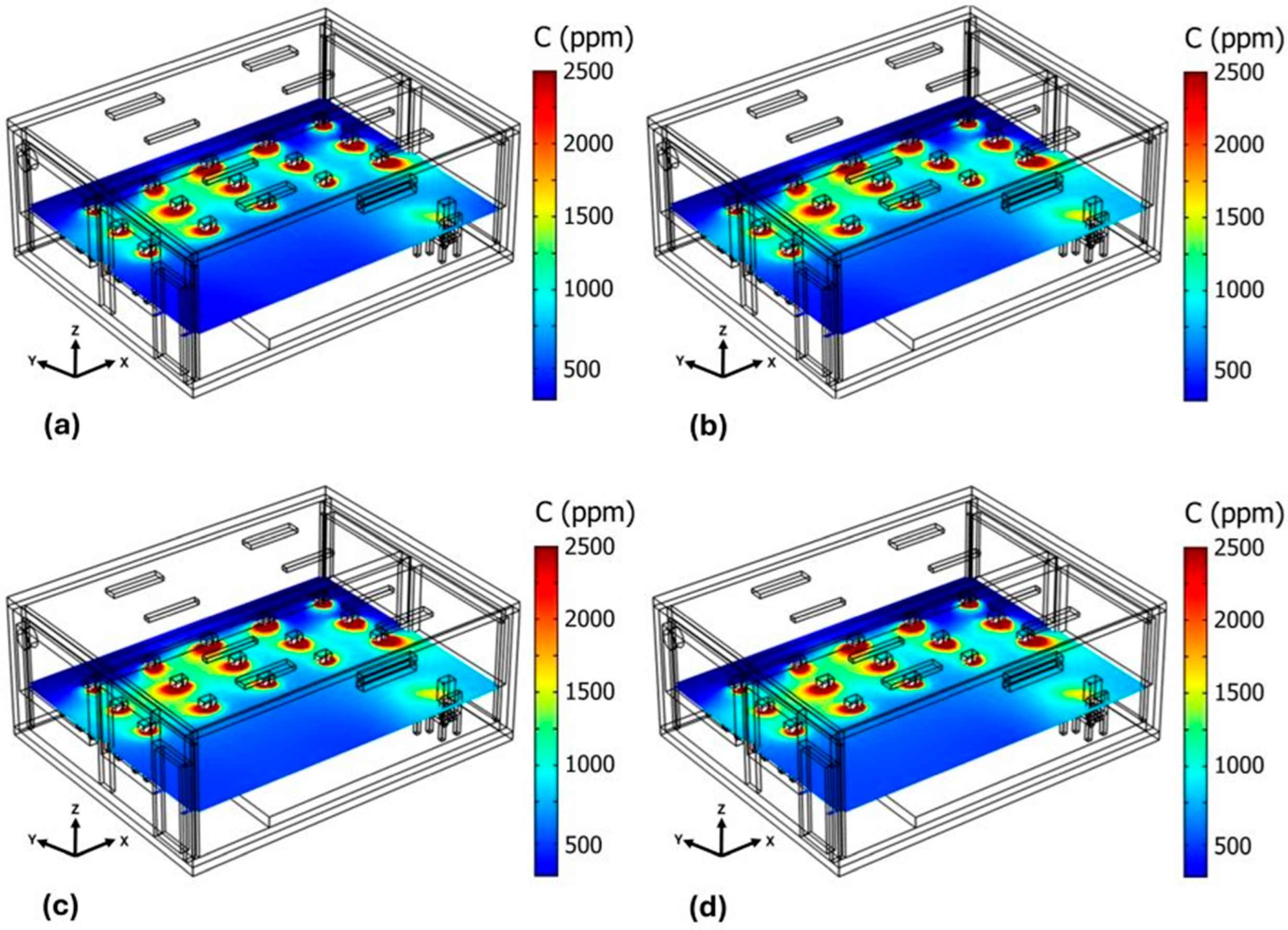
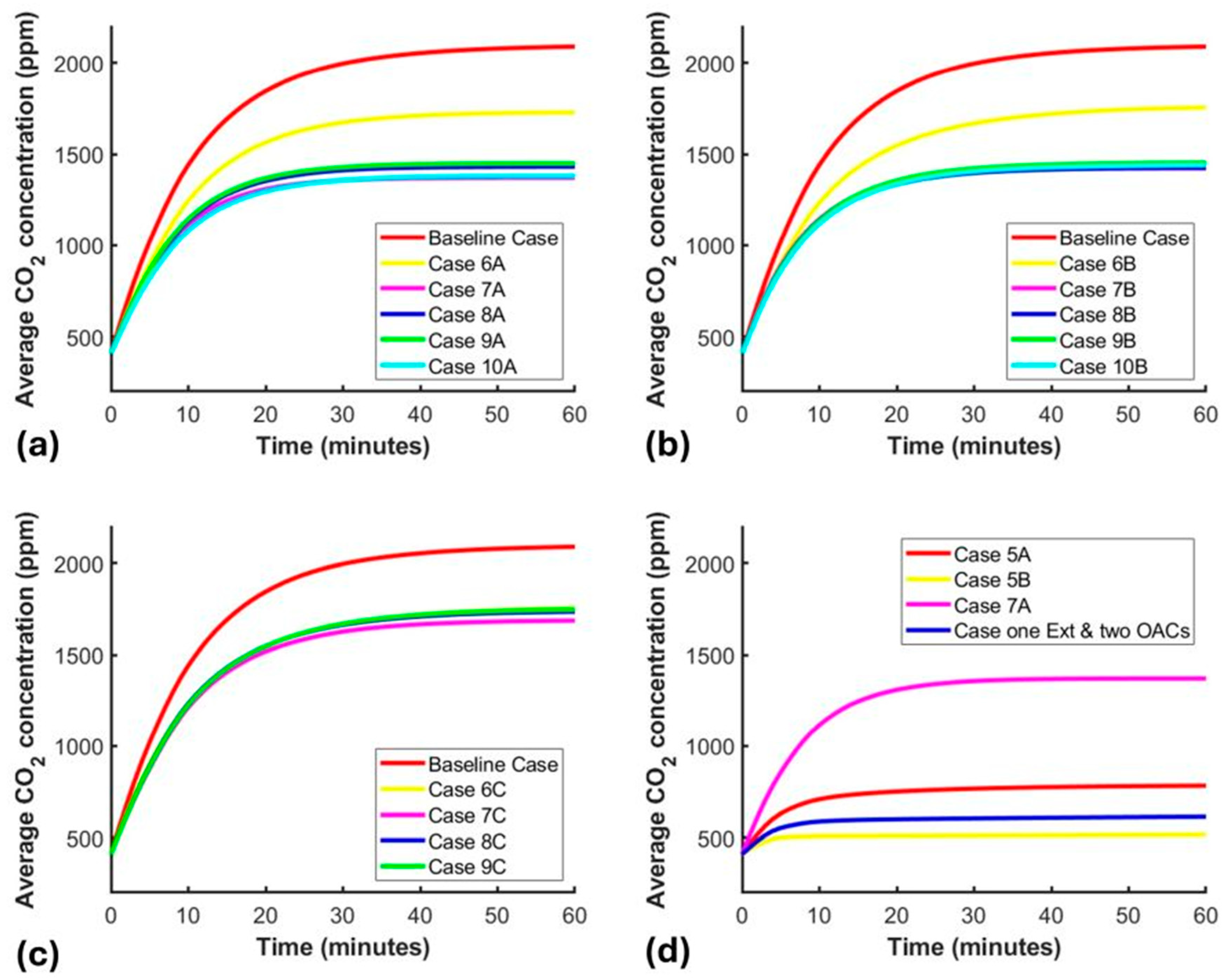

| Cases | No. of Extractors | Flow (m3/min) | |
|---|---|---|---|
| A = 1 Extractor | B = 2 Extractors | ||
| Baseline case | N/A | N/A | N/A |
| Case 1 | A | B | 13.9 |
| Case 2 | A | B | 16.2 |
| Case 3 | A | B | 18.5 |
| Case 4 | A | B | 20.8 |
| Case 5 | A | B | 23.2 |
| Cases | OACs Coordinates in Meters (x, y, z) | No. OACs | ||||
|---|---|---|---|---|---|---|
| OACs placed at ground level | ||||||
| Case 6A | - | - | (4.0,5.55,0.0) | - | - | 1 |
| Case 7A | (7.0,5.55,0.0) | - | - | - | (1.0,5.55,0.0) | 2 |
| Case 8A | (7.0,5.55,0.0) | - | (4.0,5.55,0.0) | - | (1.0,5.55,0.0) | 3 |
| Case 9A | (7.0,5.55,0.0) | (5.5,5.55,0.0) | - | (2.5,5.55,0.0) | (1.0,5.55,0.0) | 4 |
| Case 10A | (7.0,5.55,0.0) | (5.5,5.55,0.0) | (4.0,5.55,0.0) | (2.5,5.55,0.0) | (1.0,5.55,0.0) | 5 |
| OACs placed at 2 m height | ||||||
| Case 6B | - | - | (4.0,5.55,2.0) | - | - | 1 |
| Case 7B | (7.0,5.55,2.0) | - | - | - | (1.0,5.55,2.0) | 2 |
| Case 8B | (7.0,5.55,2.0) | - | (4.0,5.55,2.0) | - | (1.0,5.55,2.0) | 3 |
| Case 9B | (7.0,5.55,2.0) | (5.5,5.55,2.0) | - | (2.5,5.55,2.0) | (1.0,5.55,2.0) | 4 |
| Case 10B | (7.0,5.55,2.0) | (5.5,5.55,2.0) | (4.0,5.55,2.0) | (2.5,5.55,2.0) | (1.0,5.55,2.0) | 5 |
| OACs stacked in central part of room | ||||||
| Case 6C | (4.0,5.55,0.0) | - | - | - | - | 1 |
| Case 7C | (4.0,5.55,0.0) | (4.0,5.55,0.7) | - | - | - | 2 |
| Case 8C | (4.0,5.55,0.0) | (4.0,5.55,0.7) | (4.0,5.55,1.4) | - | - | 3 |
| Case 9C | (4.0,5.55,0.0) | (4.0,5.55,0.7) | (4.0,5.55,1.4) | (4.0,5.55,2.1) | - | 4 |
| Number of Nodes | 20 min | 40 min |
|---|---|---|
| Ca (ppm) | Ca (ppm) | |
| 350,400 | 1623.0 | 1740.2 |
| 682,047 | 1798.2 | 1932.8 |
| 912,843 | 1897.0 | 2050.9 |
| 1,250,362 | 1849.3 | 1995.2 |
| 1,565,014 | 1828.2 | 2035.1 |
| 1,740,220 | 1845.6 | 2054.8 |
| 1,923,461 | 1842.2 | 2050.3 |
| Time | PA | PB | PC |
|---|---|---|---|
| 15 min | |||
| Simulated (ppm) | 2327 | 1168 | 1603 |
| Measure (ppm) | 2335 | 1170 | 1601 |
| Error (%) | 0.34 | 0.17 | 0.12 |
| 30 min | |||
| Simulated (ppm) | 2485 | 1259 | 1735 |
| Measure (ppm) | 2500 | 1252 | 1733 |
| Error (%) | 0.60 | 0.55 | 0.12 |
| 45 min | |||
| Simulated (ppm) | 2498 | 1266 | 1745 |
| Measure (ppm) | 2483 | 1284 | 1736 |
| Error (%) | 0.60 | 1.42 | 0.52 |
| 60 min | |||
| Simulated (ppm) | 2498 | 1266 | 1746 |
| Measure (ppm) | 2505 | 1277 | 1736 |
| Error (%) | 0.28 | 0.86 | 0.57 |
Disclaimer/Publisher’s Note: The statements, opinions and data contained in all publications are solely those of the individual author(s) and contributor(s) and not of MDPI and/or the editor(s). MDPI and/or the editor(s) disclaim responsibility for any injury to people or property resulting from any ideas, methods, instructions or products referred to in the content. |
© 2025 by the authors. Licensee MDPI, Basel, Switzerland. This article is an open access article distributed under the terms and conditions of the Creative Commons Attribution (CC BY) license (https://creativecommons.org/licenses/by/4.0/).
Share and Cite
Cruz-Octaviano, E.; Ovando-Chacon, G.E.; Rodriguez-Leon, A.; Ovando-Chacon, S.L. Numerical Analysis of Air Quality Improvement and Thermal Comfort in a Classroom Using Organic Air Cleaners. Atmosphere 2025, 16, 727. https://doi.org/10.3390/atmos16060727
Cruz-Octaviano E, Ovando-Chacon GE, Rodriguez-Leon A, Ovando-Chacon SL. Numerical Analysis of Air Quality Improvement and Thermal Comfort in a Classroom Using Organic Air Cleaners. Atmosphere. 2025; 16(6):727. https://doi.org/10.3390/atmos16060727
Chicago/Turabian StyleCruz-Octaviano, Enrique, Guillemo Efren Ovando-Chacon, Abelardo Rodriguez-Leon, and Sandy Luz Ovando-Chacon. 2025. "Numerical Analysis of Air Quality Improvement and Thermal Comfort in a Classroom Using Organic Air Cleaners" Atmosphere 16, no. 6: 727. https://doi.org/10.3390/atmos16060727
APA StyleCruz-Octaviano, E., Ovando-Chacon, G. E., Rodriguez-Leon, A., & Ovando-Chacon, S. L. (2025). Numerical Analysis of Air Quality Improvement and Thermal Comfort in a Classroom Using Organic Air Cleaners. Atmosphere, 16(6), 727. https://doi.org/10.3390/atmos16060727





